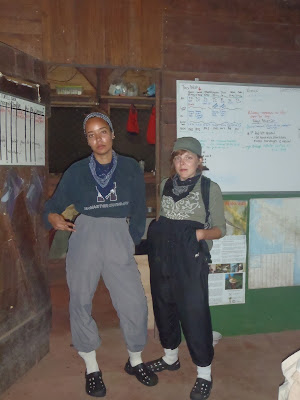Miles walked: 155
Last night was the first time I encountered what could have potentially been poachers on the beach. Usually we only see evidence of poaching (footprints, stick holes) around the nests, from people taking them for their own consumption or to sell on the black market.
Turtle eggs have been consumed by people for thousands of years as a food source since pre-colombian times and many people in the area continue the practice, though it is highly illegal. The eggs are also believed to be an aphrodisiac, sold in shot glasses with alcohol at bars. So when we saw the lights on the beach last night, we were a little apprehensive to approach the group of people with a pack of barking dogs.
Silently, we walked by, trying to determine what was going on in the pitch black. When they saw us, they immediately turned off their lights, which lead us to believe that they were doing something they weren't supposed to. From what I could see, there was a group of about 5 people with a young girl sitting on the ground, the fabric of her dress covering whatever was in the sand underneath. Intimidated by the dogs, we passed them by and walked the remainder of our transect and then turned around to observe them once again.
The second time we approached them, the dogs had stopped caring about us and we could see that they were a family with 3 kids, all digging in the sand and piling it up between them. They were giggling nervously and pointing at the rough image of a turtle they had made in the sand since we passed the first time. To avoid conflict, we are not allowed to accuse people of poaching, nor are we able to tell them that they cannot be on the beach between 6pm and 5am. Some tourists and local people just enjoy watching the turtles at night, and some even dig up the hatchlings to take them to the sea. We don't know for certain what they were up to but there was alot of disturbed sand around them. It was clear that they knew we were from Cano Palma and the fact that they were digging was the elephant on the beach that nobody could address. The only thing that we could ask them was to not use their white light so to not disturb nesting turtles. We thanked them and said good night but about a half a mile down the beach, we could see that they were using their lights again. Since the government does not routinely monitor the area, it seems the presence of three gringas is a weak force that does not deter people from being on the beach.
For the rest of the 6 mile walk, this incident was all I could think about. This was exactly the kind of thing I wanted to encounter here - the kind of experience you can't gain from reading an ecology textbook. I know that there is often a strong contention between conservation and social needs, but I had yet to see this in person. Most of my theoretical knowledge on this issue has been very black and white: poaching = bad, conservation = good and the only way to enforce this is through heavy top-down enforcement. This incident was very grey though, part of me understands why people poach but another part of me wants to condemn them for jeopardizing a critically endangered species. Some of the poachers are well known from the nearby village of San Francisco, and turtle eggs are an easy way to make some extra money from a beach that is not effectively monitored.The government of Costa Rica has declared the consumption of sea turtle meat and eggs illegal and though people are aware of this, they are still compelled to break the law. One course in Tropical Conservation last year opened my eyes to the idea of "community based conservation", which is an all encompassing, bottom up approach to conservation that includes and considers the needs of local people, instead of exculding them from conservation initaitives. I've been racking my brain ever since last night to try and think of a way that San Francisco can implement community based conservation to benefit both turtles and people. I know that sea turtle conservation is taught to the local elementary school, but the fact that there were children on the beach last night makes me believe that this has limited efficacy. Conservation is such a tricky balancing act between preserving biodiversity and including local social needs but I truly believe that it can be achieved through community based conservation.
Here's an case I researched in a course last year, in Ostional Costa Rica, the government allows for people to harvest turtle eggs and in exchange, they protect the turtles from illegal poaching. Unfortunately our beach does not have the species of turtle that would allow for controlled harvest, but it provides some insight into innovative conservation practices.
Some more pictures from this week:
Cat eyed snake (Leptodeira septentrionalis)
An ogre spider, that blue rectangle is a net that it throws over it's prey
Slaty Tailed Trogon (Trogon messena)
the pool across the canal
Playing walkie talkie dress up
...at least the sand flies have a sense of humour
White faced capuchin monkey (Cebus capucinus)
Emerald basilisk disproves of you
pretty much sums up my afternoons here
Me and Costroza (spanish for scabby). She walks 6 miles on the beach with us on morning patrol.
Demon Maggie demands food


























































